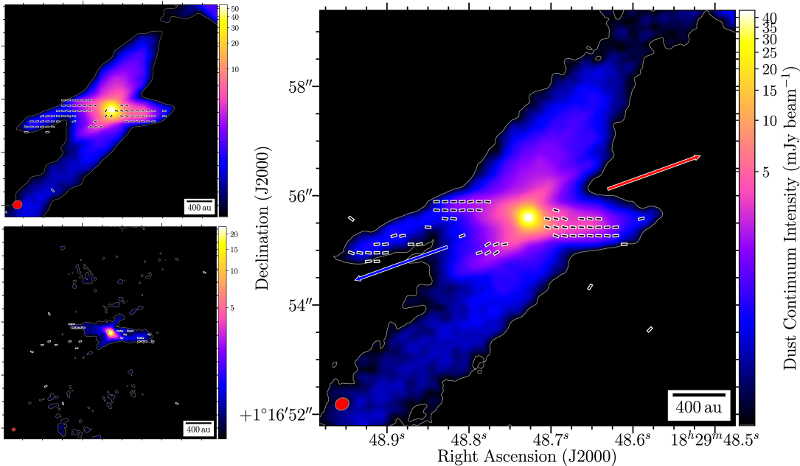| EPoS Contribution |
|
Statistics on ALMA Dust Polarization Observations of Young Protostellar Cores
Valentin LeGouellec CEA/ESO, Santiago de Chile, CL | |
| With the aim of characterizing the role played by magnetic fields in the formation of young protostars, several recent studies have revealed unprecedented features toward high angular resolution ALMA dust polarization observations of Class 0 protostellar cores. Especially, the dust polarization has been found to be interestingly enhanced along the cavity walls of bipolar outflows, which are subject to high irradiation from the reprocessed radiation field of the central protostar. In addition, highly polarized dust thermal emission have been detected in region most likely linked with the infalling envelope within the equatorial plane, in the form of filamentary structure being potential magnetized accretion streamer. These observations allow us to investigate the different physical processes involved in the Radiative Alignment Torques (RATs) acting on dust grains from the core to disk scales. Notably, we propose that the polarized emission we see at millimeter wavelengths along the irradiated cavity walls can be reconciled with the expectations of RAT theory if the aligned grains present at < 500 au scales in Class 0 envelopes have grown larger than what is typically expected in young protostellar cores. To improve our understanding of the physical processes involved in the efficiency of dust alignment in a protostar, we gathered all the available ALMA dust polarization observations of Class 0 protostars, and performed a statistical analysis examining the trend between the dispersion of polarization position angles and the fractional polarization. We find a robust correlation allowing us to investigate a potential variation of the grain alignment efficiency toward a prototypical Class 0 protostellar core. Moreover, we compare these results with synthetic observations of POLARIS onto non-ideal MHD simulations of collapsing protostars. We compare the correlations derived from the simulations and detailed the impact that both, filtering and the dust grain alignment characteristics put into POLARIS, have on the statistics we developed. Our recent work, that make use of statistics run onto ALMA dust polarization observations and synthetic observations of numerical simulations, allows us to better characterize the principal causes responsible for the grain alignment characteristics within a protostellar core. | |
 | |
| Caption: Magnetic field around Serpens Emb 8(N). The three panels correspond to three different angular resolution, from the lowest in the top-left panel, to the highest in the bottom-left panel. Line segments represent the magnetic field orientation. The color scale is the total intensity (Stokes I) of the thermal dust emission. The blue and red arrows represent the directions of the blueshifted and redshifted lobes of the bipolar outflow, respectively. The polarized emission is clearly enhanced along the outflow cavity walls visible in the dust thermal emission. | |
| Collaborators: C. Hull, NAOJ/JAO, CL A. Maury, CEA, FR J.M. Girart, ICE-CSIC, ES |
Key publication
Suggested Session: Magnetic Fields |

